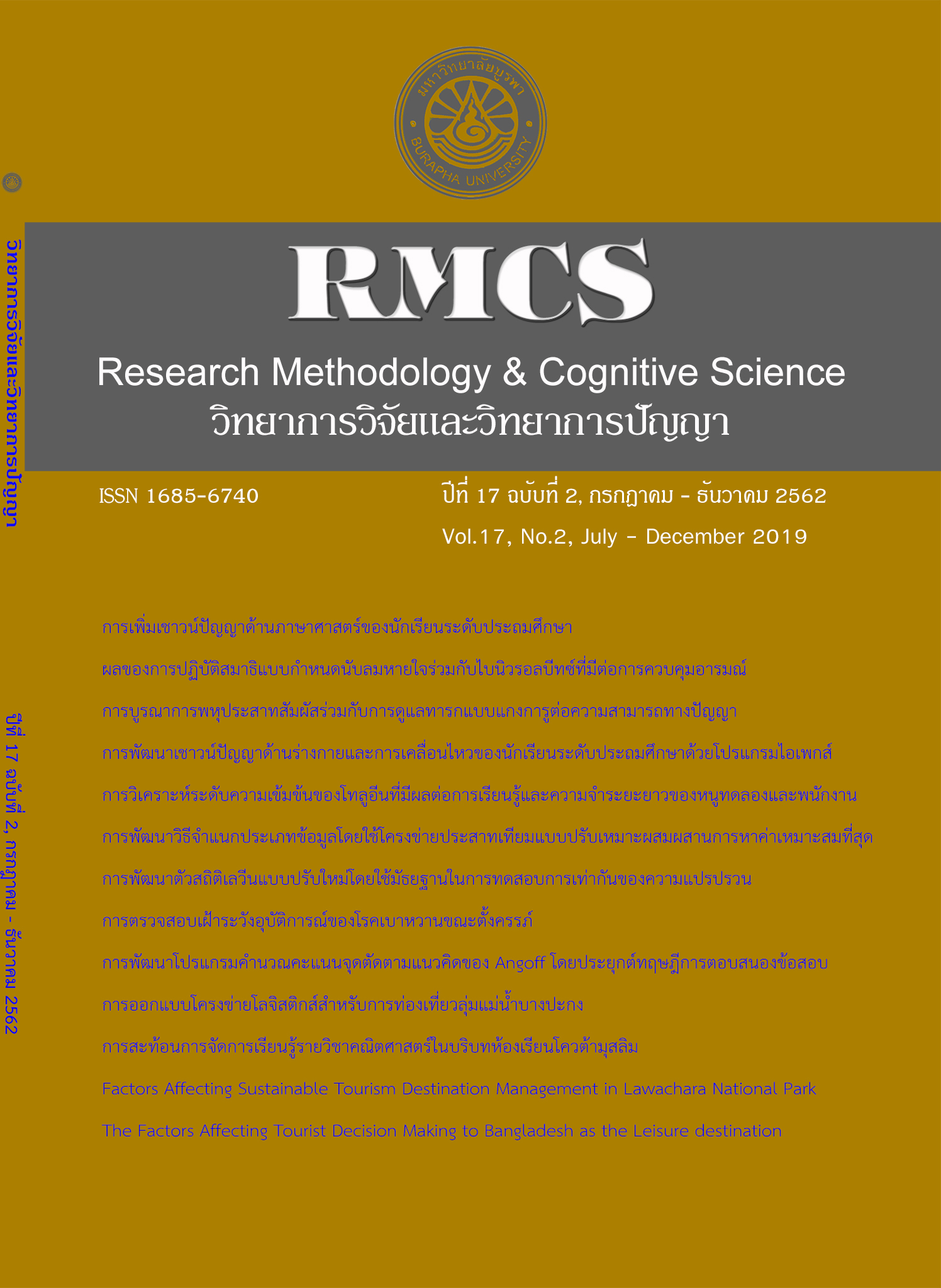Logistics Network Design for Tourism at Bangpakong Riverside
Main Article Content
Abstract
This research aimed to analyze and design the logistics network for tourism along the Bang Pakong riverside. A mixed-method design was used with the research involving two phases. In the first phrase, the analysis of the logistics network used content analysis, a survey, and the focus-group technique. In the second phrase, the design of the logistics network used the systems development life cycle method as seen in the waterfall model by Arc Gis v.10.5 program. The quality evaluation of the logistics network for tourism was based on suitability and satisfaction possibility assessments.
The results indicated that:
- The logistics network components for tourism consisted of 13 components with 77 indicators.
- The principles for designing the logistics network for tourism (WIN-4CS) included eight points - the well-known tourism attractions, the identity preservation of tourism attractions, the availability of tourism network, travel convenience, community engagement, the distance (time) between tourism attractions, the availability of tourism logistics components, and the standard of upkeep of the attractions.
- The logistics network for tourism along the Bang Pakong riverside consisted of six logistics networks. The logistics network for tourism in one-day trips consisted of three networks, and the logistics network for tourism in two-day trips consisted of three networks.
4. The quality evaluation of the logistics network for tourism along the riverside showed that all six routes had high suitability, and a high possibility of satisfaction.
Article Details
References
จุฑาภรณ์ หินซุย และสถาพร มงคลศรีสวัสดิ์. (2557). แนวทางส่งเสริมการท่องเที่ยวเชิงพุทธ กรณีศึกษาวัดประชาคมวนาราม อำเภอศรีสมเด็จ จังหวัดร้อยเอ็ด. วารสารวิชาการการท่องเที่ยวไทยนานาชาติ, 10(1), 50-58.
ชายชาญ ปฐมกาญจนา และนรินทร์ สังข์รักษา. (2558). แนวทางการส่งเสริมการท่องเที่ยวเชิงวัฒนธรรมแบบมีส่วนร่วมของชุมชนตลาดบางหลวง อำเภอบางเลน จังหวัดนครปฐม. วารสารวิทยบริการมหาวิทยาลัยสงขลา
นครินทร์, 26(1), 128-129
ปิรันธ์ ชิณโชติ และธีระวัฒน์ จันทึก. (2559). รูปแบบการจัดการการท่องเที่ยวเชิงสร้างสรรค์ของสวนผึ้ง. Veridian E-Journal, Silpakorn University, 9(1), 250-268.
ภัชรบถ ฤทธิ์เต็ม. (2558). รูปแบบการจัดการท่องเที่ยวเชิงศาสนาและวัฒนธรรมในวัด. วารสารศิลปศาสตร์ มหาวิทยาลัยอุบลราชธานี, 11(1), 1-23.
รุ่งวิทย์ ตรีกุล, กมล เสวตสมบูรณ์ และธนชาติ เราประเสริฐ. (2558). การมีส่วนร่วมของชุมชนบึงพลาญชัยในการจัดการการท่องเที่ยวอย่างยั่งยืน. วารสารวิทยาลัยบัณฑิตศึกษาการจัดการ, 8(1), 133-150.
เศรษฐวัสภุ์ พรมสิทธิ์ และนราศรี ไววนิชกุล. (2559). ปัจจัยที่มีอิทธิพลต่อการจัดการโลจิสติกส์การท่องเที่ยวในเขตกรุงเทพมหานคร. วารสารมนุษยศาสตร์และสังคมศาสตร์ มหาวิทยาลัยมหาสารคาม, 35(4), 138-147.
สายชล ปัญญชิต และภูเบศ วณิชชานนท์. (2558).การท่องเที่ยวทางพระพุทธศาสนาและวัฒนธรรมของภาคใต้: การพัฒนาเส้นทางและผลกระทบ. วารสารสังคมศาสตร์ มหาวิทยาลัยศรีนครินทรวิโรฒ, 58(2), 247-262.
สำนักงานคณะกรรมการพัฒนาการเศรษฐกิจและสังคมแห่งชาติ. (2559). แผนงานพัฒนาระเบียงเศรษฐกิจภาคตะวันออก (พ.ศ. 2560-2564). กรุงเทพฯ: สำนักงานคณะกรรมการพัฒนาการเศรษฐกิจและสังคมแห่งชาติ.
อดิศักดิ์ สมแสน. (2558). การพัฒนาแหล่งท่องเที่ยวแบบยั่งยืน ตามแนวปรัชญาของเศรษฐกิจพอเพียงในเขตพื้นที่ปกครองพิเศษ (เมืองพัทยา). Journal of Nakhonratchasima College, 9(2), 28-38.
Antonson, H., & Jacobsen, J. K. S. (2014). Tourism development strategy or just brownsignage? Comparing road administration policies and designation proceduresfor official tourism routes in two Scandinavian countries. Land Use Policy, 36, 342-350.
Denstadli, J. M., & Jacobsen, J. K. S. (2011). The long and winding roads: Perceived quality of scenic tourism routes. Tourism Management, 32(4), 780-789.
Denstadli, J. M., Jacobsen, J. K. S., & Lohmann, M. (2011). Tourist perceptions of Summer weather in Scandinavia. Annals of Tourism Research, 38(3), 920-940.
Edmonds, W. A. & Kennedy, T. D. (2017). An applied guide of research designs: Quantitative, qualitative, and mixed methods. USA: Sage Publications.
Goeldner, C., & Ritchie, B. (2012). Tourism: Practices, principles, philosophies. NewJersey: John Wiley and Sons, inc.
Lawton, L. J., & Weaver, D. B. (2010). Normative and innovative sustainable resource management at birding festivals. Tourism Management, 31(4), 527-536.
Lohmann, G., & Duval, D. T. (2011). Critical aspects of the tourism-transport relationship. Contemporary Tourism Reviews, 1-37.
Ong, C. E., & Du, C. H. (2012). The Post-Mao gazes: Chinese backpackers in Macau. Annals of Tourism Research, 39(2), 735-754.
Thumachai, C., Chawalit. P., Chinnakum, W., Chaiboonsri, C., & Saosaovaphak, A. (2017). A supply chain analysis of incentive travels: A case of Thailand. Center of Tourism Research and Development, 6(1), 155-164.
Tsai, C. T., & Wang, Y. C. (2017). Experiential value in branding food tourism. Journal of Destination Marketing and Management, 17(6), 56-65.

